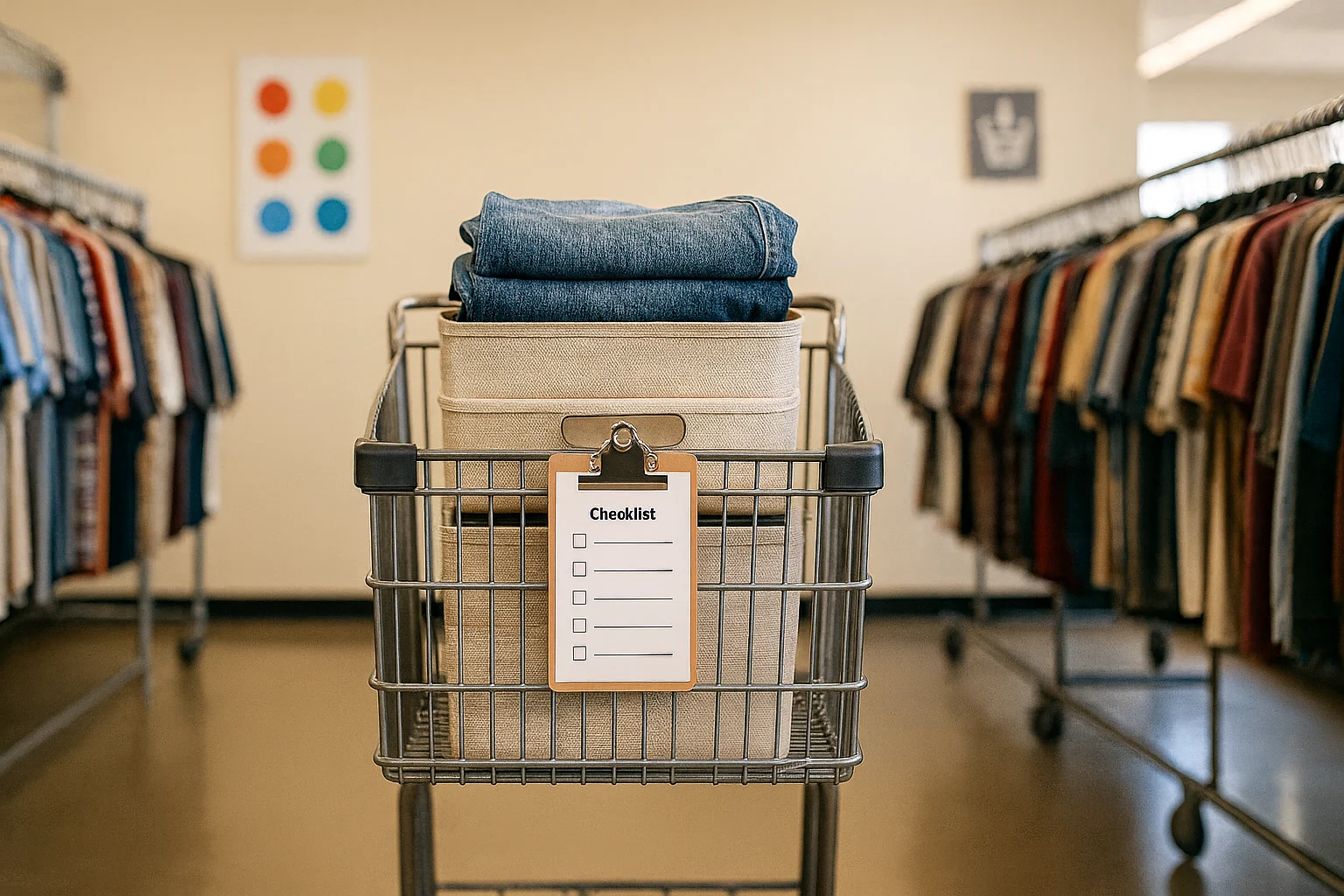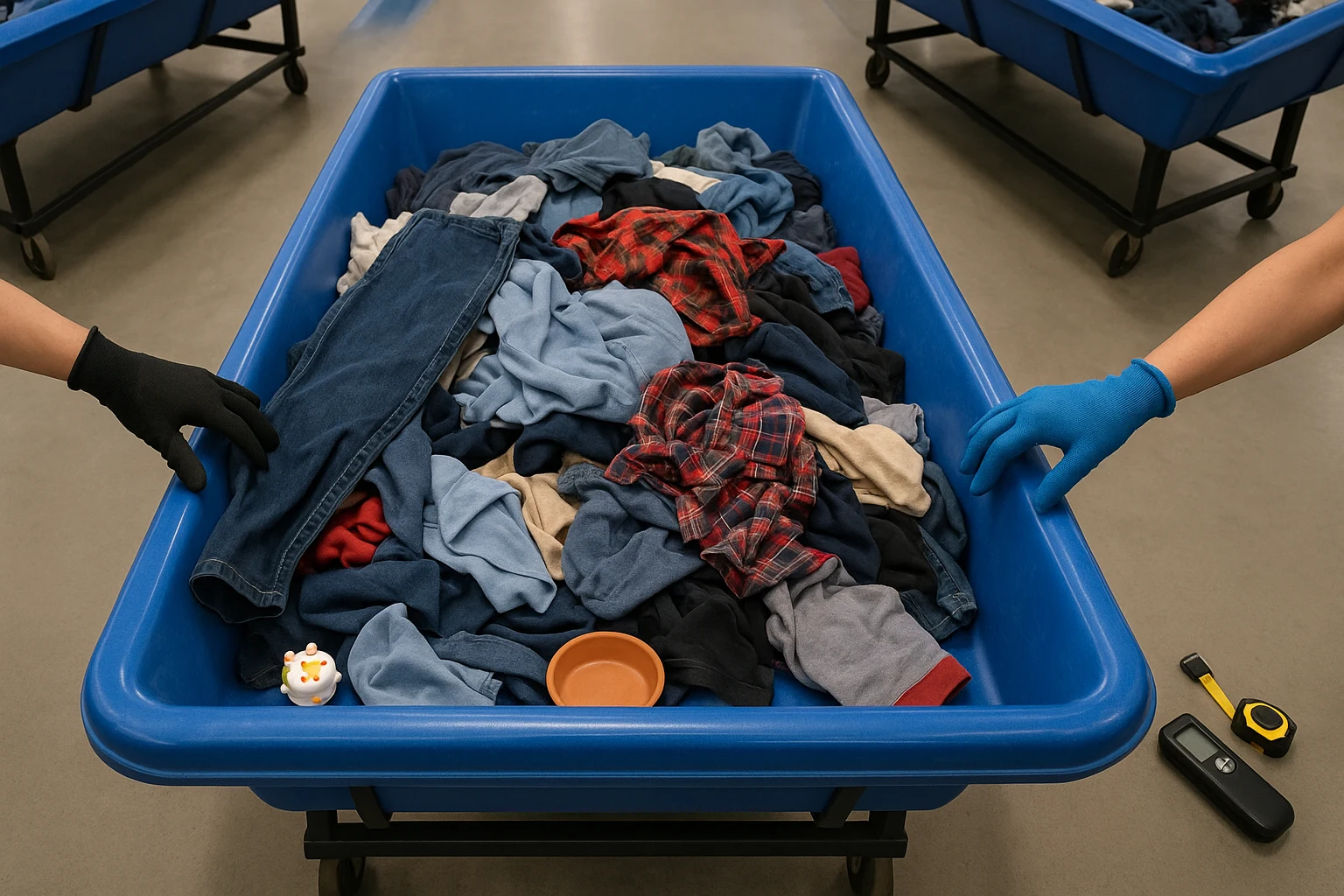
Want better thrift wins in less time? Plan your run, shop with a checklist, and clean finds fast—so smarter Goodwill trips become your norm. If you’ve tried thrifting and left empty-handed, this quick walkthrough of thrifting goodwill shows the best days to go, which racks to scan first, and what to check before you buy—then zoom out with our broader frugal fashion guide.
Your Best-Fit Thrifting Planner
Answer four quick questions and get a simple, tailored plan.
💡
Table of Contents
- Key Takeaways
- Goodwill-Specific Strategies
- Where to Shop Beyond Goodwill
- Online Thrifting Platforms
- Inspection & Cleaning Basics
- Where to Buy Vintage Clothing Online
- Frequently Asked Questions
- Why Thrifting Pays Off
- Conclusion
Key Takeaways
- Timing wins: Mid-week mornings often beat weekends because stock is fresher and aisles are calmer.
- Check quality fast: Seams, zips, soles, power-on tests—then price vs. repair.
- Clean smart: Treat stains you’re comfortable with; sanitize hard goods; air out textiles.
- Look beyond Goodwill: Charity shops, consignment, estate sales, and community events are goldmines.
- Save & sustain: Secondhand stretches your budget and reduces waste.
New to the organization? For programs and store models, see Goodwill Industries.
Thrifting Goodwill: Store-Specific Strategies
Short on time? Track your store’s color-tag rotations, note restock windows, and ask about discounts so you hit the best racks first. If there’s an outlet nearby, do a fast, gloves-on sweep for bulk textiles and craft stock before regular stores. Quick wins first, deeper digs later. In dense areas—think second hand shopping NYC—stack stores by opening times and donation days to cover more ground in less time. If you bring home pieces that need tweaks, try these quick clothing fixes to stretch your budget even further. Use these second hand shopping tips: track restocks, scan sale tags first, and time weekday mornings. For volume sourcing, here’s where to buy second hand clothes in bulk—Goodwill Outlet (Bins) and local liquidators. If you’re wondering “is Goodwill good for thrifting,” the short answer is yes, especially when you time visits to restocks and color-tag changes.
Thrifting 101: Quick Start
Start small: set a 20–30 minute limit, pick two categories, and carry a tape and batteries. Move fast, then decide in good light. This beginner pass keeps decisions simple and your cart focused.
Thrifting hacks: route stores by opening times, scan the sale color first, and bail after 15–20 minutes if racks look stale.

Where to Shop Beyond Goodwill
Goodwill is a great start, but widen your net. Local charity shops often price lower and support community programs, and a nearby second hand fashion store can be just as affordable. Consignment shops skew higher quality, so you’ll see better brands at still-friendly prices. Flea markets and antique malls reward patience; bring cash and be ready to haggle. Estate sales are excellent for furniture, tools, and kitchenware—go early for selection or late for markdowns. Church rummage and community sales can be surprisingly affordable and full of finds. For furnishing on a budget, skim our frugal home furnishing guide before you shop.
Where to Buy Vintage Clothing Online: Best Platforms
Prefer a digital hunt? Start with Poshmark or Depop—filter by size, brand, and fabric, then send polite offers. If you’re wondering where to buy vintage clothes cheap, set saved searches, use price filters, and watch auctions to spot underpriced listings. eBay is strong for vintage, collectibles, and hard goods; create alerts and keep an eye on shipping. For big items, try Facebook Marketplace and local Buy Nothing groups, and meet safely with a friend. Want curated picks? ThredUp (everyday) and The RealReal (luxury) pre-screen items, so prices run higher but browsing is easier. Hunting free finds locally? Bookmark our best freebies list. Ready to resell? Here’s where to sell vintage clothing online—Poshmark, eBay, Depop, and local marketplace groups.
This post contains affiliate links. If you buy through our links, we may earn a commission at no extra cost to you. Learn more.
Where to Buy Vintage Clothing Online
Shopping for vintage clothes online? Start with reputable second hand fashion store marketplaces and charity shops that list inventory. Filter by size and fabric, save searches for alerts, and pick up in-store when possible to avoid return hassles.
Inspection & Cleaning Basics
Run a simple pass: seams, soles, zips, buttons. Test electronics where allowed. Sniff for odors you’re willing to treat at home, and skip items you’re not confident you can safely clean or repair. Clean keepers right away so they’re ready to wear or resell without lingering in a pile. In second hand shopping New York or any big-city market, ask about return windows and electronics test stations before you buy. Stock up on low-cost homemade cleaning solutions so you can refresh finds the same day.
What to Wear Thrifting
Dress in easy layers, closed-toe shoes, and socks so trying on is quick. Use a small hands-free bag and bring light gloves for bins.
When in doubt about delicate fabrics, electronics, or possible pest issues, consult a qualified cleaner or technician. For safety-critical gear and appliances, always check the latest recalls on the U.S. Consumer Product Safety Commission website.
| Item | What to check | Fast test |
|---|---|---|
| Denim | Hems, inseams, zipper, hardware | Gentle tug at belt loops; zip smoothly |
| Knitwear | Pilling, cuffs, underarms | Stretch and release—does it recover? |
| Shoes | Outsole wear, midsole crumble, insole smell | Bend test at toe; press heel for cracks |
| Electronics | Cords, battery door, corrosion | Plug in or test with spare batteries |
What to Absolutely Avoid
- Infant car seats & helmets: Buy new—unknown history can be unsafe.
- Mattresses or upholstery with pest signs: Walk away at the first hint of bed bugs or frass.
- Electronics you can’t test: Unless you’re repairing, assume it needs parts.
- Strong, set-in odors: Smoke, mildew, or heavy pet smells are hard to remove.
Special Care for Unique Items
Books: Wipe covers and air out with baking soda or activated charcoal in a sealed bin. Toys: Hard plastics handle hot, soapy water; plush may go in a delicates wash—check seams first. Kitchenware: Run dishes through a sanitize cycle or wash in hot, soapy water; boil metal utensils if you like. Delicates: Wool, silk, and cashmere prefer cool water and flat drying; a steamer refreshes without rough agitation. For sofas and chairs, this upholstery cleaner recipe is a budget-friendly refresh.
Safety first: For baby gear, helmets, car seats, cords, and small appliances, check recent product recalls via the U.S. Consumer Product Safety Commission before buying.
Frequently Asked Questions
Why Thrifting Pays Off
- Save big: Quality denim for a few dollars, solid-wood furniture for a fraction of retail, and home goods that cost less than lunch.
- Shop greener: Each secondhand buy diverts usable items from landfills and lowers demand for new manufacturing.
- Stand out: Pre-loved pieces help you build a personal style that isn’t on every rack.
- Give back: Many stores fund job training and local services, so your finds support community work while stretching your budget.
Conclusion
With a simple plan, quick checks, and consistent timing, browsing turns into real wins. Want an easy start? Pick one store, one day, and try the tool above this week to make it feel effortless.
This guide is for general education, not professional or legal advice. Always follow store policies, local regulations, and product safety guidance. For safety-critical items (baby gear, helmets, car seats, electronics), consider buying new or verifying recalls via trusted sources.